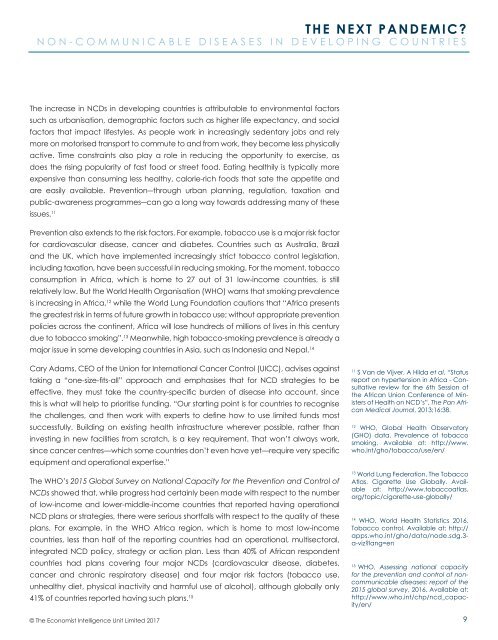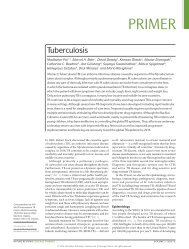THE NEXT PANDEMIC?
The_next_pandemic
The_next_pandemic
You also want an ePaper? Increase the reach of your titles
YUMPU automatically turns print PDFs into web optimized ePapers that Google loves.
<strong>THE</strong> <strong>NEXT</strong> <strong>PANDEMIC</strong>?<br />
NON-COMMUNICABLE DISEASES IN DEVELOPING COUNTRIES<br />
The increase in NCDs in developing countries is attributable to environmental factors<br />
such as urbanisation, demographic factors such as higher life expectancy, and social<br />
factors that impact lifestyles. As people work in increasingly sedentary jobs and rely<br />
more on motorised transport to commute to and from work, they become less physically<br />
active. Time constraints also play a role in reducing the opportunity to exercise, as<br />
does the rising popularity of fast food or street food. Eating healthily is typically more<br />
expensive than consuming less healthy, calorie-rich foods that sate the appetite and<br />
are easily available. Prevention―through urban planning, regulation, taxation and<br />
public-awareness programmes―can go a long way towards addressing many of these<br />
issues. 11<br />
Prevention also extends to the risk factors. For example, tobacco use is a major risk factor<br />
for cardiovascular disease, cancer and diabetes. Countries such as Australia, Brazil<br />
and the UK, which have implemented increasingly strict tobacco control legislation,<br />
including taxation, have been successful in reducing smoking. For the moment, tobacco<br />
consumption in Africa, which is home to 27 out of 31 low-income countries, is still<br />
relatively low. But the World Health Organisation (WHO) warns that smoking prevalence<br />
is increasing in Africa, 12 while the World Lung Foundation cautions that “Africa presents<br />
the greatest risk in terms of future growth in tobacco use; without appropriate prevention<br />
policies across the continent, Africa will lose hundreds of millions of lives in this century<br />
due to tobacco smoking”. 13 Meanwhile, high tobacco-smoking prevalence is already a<br />
major issue in some developing countries in Asia, such as Indonesia and Nepal. 14<br />
Cary Adams, CEO of the Union for International Cancer Control (UICC), advises against 11<br />
S Van de Vijver, A Hilda et al, “Status<br />
taking a “one-size-fits-all” approach and emphasises that for NCD strategies to be report on hypertension in Africa - Consultative<br />
review for the 6th Session of<br />
effective, they must take the country-specific burden of disease into account, since the African Union Conference of Ministers<br />
of Health on NCD’s”, The Pan Afri-<br />
this is what will help to prioritise funding. “Our starting point is for countries to recognise<br />
can Medical Journal, 2013;16:38.<br />
the challenges, and then work with experts to define how to use limited funds most<br />
12<br />
successfully. Building on existing health infrastructure wherever possible, rather than WHO, Global Health Observatory<br />
(GHO) data, Prevalence of tobacco<br />
investing in new facilities from scratch, is a key requirement. That won’t always work,<br />
smoking. Available at: http://www.<br />
since cancer centres—which some countries don’t even have yet—require very specific who.int/gho/tobacco/use/en/<br />
equipment and operational expertise.”<br />
13<br />
World Lung Federation, The Tobacco<br />
The WHO’s 2015 Global Survey on National Capacity for the Prevention and Control of Atlas, Cigarette Use Globally. Available<br />
at: http://www.tobaccoatlas.<br />
NCDs showed that, while progress had certainly been made with respect to the number<br />
org/topic/cigarette-use-globally/<br />
of low-income and lower-middle-income countries that reported having operational<br />
NCD plans or strategies, there were serious shortfalls with respect to the quality of these<br />
14<br />
WHO, World Health Statistics 2016,<br />
plans. For example, in the WHO Africa region, which is home to most low-income Tobacco control. Available at: http://<br />
apps.who.int/gho/data/node.sdg.3-<br />
countries, less than half of the reporting countries had an operational, multisectoral,<br />
a-viz?lang=en<br />
integrated NCD policy, strategy or action plan. Less than 40% of African respondent<br />
countries had plans covering four major NCDs (cardiovascular disease, diabetes, 15<br />
WHO, Assessing national capacity<br />
cancer and chronic respiratory disease) and four major risk factors (tobacco use, for the prevention and control of noncommunicable<br />
diseases: report of the<br />
unhealthy diet, physical inactivity and harmful use of alcohol), although globally only 2015 global survey, 2016. Available at:<br />
41% of countries reported having such plans. 15 http://www.who.int/chp/ncd_capacity/en/<br />
© The Economist Intelligence Unit Limited 2017<br />
9




